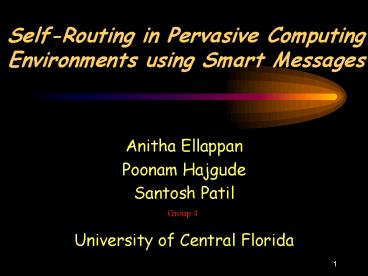Self-Routing in Pervasive Computing Environments using Smart Messages PowerPoint PPT Presentation
Title: Self-Routing in Pervasive Computing Environments using Smart Messages
1
Self-Routing in Pervasive Computing
Environments using Smart Messages
- Anitha Ellappan
- Poonam Hajgude
- Santosh Patil
- University of Central Florida
Group 4
2
Networks of Embedded Systems
Incorporating intelligence in devices and
providing them network connectivity
Linux Camera
Linux Car
- Functionally heterogeneous nodes
- Very large scale
- Ad hoc topologies
- Dynamic network configurations
- Limited a priori knowledge about network
resources
3
Programmability Challenge
- Traditional message passing distributed computing
does not work for networks of embedded systems - unknown and volatile network configurations
- end-to-end data transfer may hardly complete
(i.e., all or nothing semantics is not
appropriate) - fixed address naming and routing (e.g., IP) are
too rigid - Solution Cooperative Computing using Smart
Messages - More flexible naming and routing are needed
- applications interested in content/services, not
individual nodes - different applications have different routing
requirements
4
Outline
- Motivation
- Smart Messages Overview
- Self-Routing Mechanism
- content-based migration
- application scenarios
- Evaluation
- SM prototype
- simulations
- Conclusions Future Work
5
Smart Messages at a Glance
- Distributed computing using execution migration
- Applications composed of one or multiple Smart
Messages - Smart Message (SM)
- composed of code, data, and execution state
- executes on nodes of interest named by properties
- Cooperative Nodes
- execution environment (Virtual Machine)
- content-based memory (Tag Space)
- Self-Routing
- routing performed at application-level
- applications can change routing during execution
6
Application example
EZCab - An application for locating and booking
free cabs in densely crowded traffic
environments.
7
Smart Messages
- Migratory execution units consisting of code and
data section (Bricks) and a light weight
execution state. - Goal
- To reduce the support required from nodes by
placing parts of intelligence in SMs - This provides flexibility and obviates the
difficulty of reprogramming the network for new
application
8
Node Architecture System Support provided by
nodes
Execution is non-preemptive, but time bounded
Admission prevents excessive use of resources
sm1
SM arrival
Virtual Machine
Admission Manager
SM migration
sm2
SM Ready Queue
- Two types of tags
- application tags (Temp)
- I/O Tags (Permanent)
- Tags used by SMs for
- routing
- data exchange
- synchronization
- I/O access
tag1
tag2
Tag Space
Identifier Name of tag Data Application
specific
9
Smart Messages Migration
migrate(Taxi)
Taxi
Taxi
1
2
3
4
sys_migrate(2)
sys_migrate(3)
sys_migrate(4)
- Two level migration
- migrate()
- embeds routing algorithm
- migrates application to next node of interest
- names nodes in terms of arbitrary conditions
- on tag names and tag values
- sys_migrate()
- one hop migration
- used to implement migrate
10
Self-Routing
- Smart Messages carry the routing and execute it
at each node - Smart Messages control their routing
- select routing algorithm (migrate primitive)
- from multiple library implementations
- implement a new one
- change routing algorithm during execution
- in response to adverse network conditions
- according to applications requirements
11
Dynamic Change of Routing (1)
Dense network Low mobility Proactive routing
Sparse network High mobility On-demand routing
12
Dynamic Change of Routing (2)
space-bound on-demand routing to reach the nodes
of interest
geographical routing to reach circle
13
Smart Messages Routing Algorithms
- Goal Evaluate the potential of SMs to implement
different content-based routing algorithms - on-demand content-based routing (similar to AODV
Perkins 99) - greedy geographical routing (similar to GPSR
Karp 00) - proactive routing using Bloom filters (similar to
Probabilistic Routing Rhea 02) - rendez-vous routing (combining on-demand and
proactive routing) - e.g., geographic dissemination limited flooding
- advantage improves the response time for
applications while avoiding global dissemination
and large scale flooding
14
Evaluation Strategies (1)
- Implementation
- SM prototype over Sun Java KVM on HP iPAQs
- small scale network (8 nodes)
- evaluated the effects of code caching
15
Evaluation Strategies (2)
- Simulation
- SM simulator
- large scale network (256 nodes)
- evaluated the effects of best routing selection
and dynamic change of routing - Metrics
- completion time user-observed response time for
an application - total number of bytes sent total amount of
traffic generated by an application - also indicates the energy and bandwidth consumed
by an application
16
On-Demand Routing vs. Geographical On-Demand
Routing
- 3 nodes of interest located in the corners
- have to be visited in clockwise order
- application has knowledge about these nodes
regions - vary the radius from 100m to 700m
starting node
node of interest
other node
17
Conclusions
- Self-Routing provides high flexibility for SM
applications - choose the routing
- implement their own routing
- change the routing dynamically
- Self-Routing has performance benefits
- improved response time for applications
- significant energy and bandwidth savings in the
network
18
Future Work
- Spatial Programming with Smart Messages
- programming model for networks of embedded
systems - network resources accessed transparently using
space, tag spatial references - a node referenced by space, tag is reached
through a combination of geographical and
content-based routing - Design and implement real world applications
using Smart Messages and self-routing
19
References
- Cristian Borcea, Chalermek Intanagonwiwat,
Akhiles Saxena, Liviu Iftode, Self-Routing in
Pervasive Computing Environments using Smart
Messages, First IEEE Conference on Pervasive
Computing and Communications, 2003. - Cristian Borcea, Deepa Iyer, Porlin Kang,
Akhilesh Saxena, and Liviu Iftode, Cooperative
Computing for Distributed Embedded Systems 22nd
International Conference on Distributed Computing
Systems, July 2002. - Banavar G, Beck J, Gluzberg E, Munson J, Sussman
JB, Zukowski D, Challenges An Application Model
for Pervasive Computing. Sixth ACM
MOBICOM,Boston,2000.
20
Thank you

